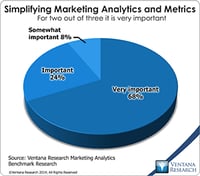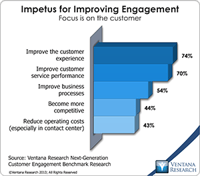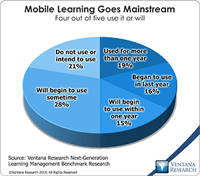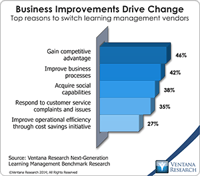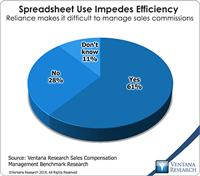Managing marketing performance is anything but simple. It requires establishing a unified approach to assess the outcomes of initiatives and projects and compare results with investments in marketing people and campaigns. In general, while performance management has been conducted effectively at the corporate levels, it has been a challenge for most lines of business, marketing departments included.
Read More
Topics:
Social Media,
Marketing,
Marketing Performance Management,
Marketing Planning,
Operational Performance Management (OPM),
Business Analytics,
Business Intelligence,
Uncategorized,
Business Performance Management (BPM),
CMO,
Customer Performance Management (CPM),
Demand Generation,
Sales Performance Management (SPM)
Organizations in all industries face various difficulties in managing product information. The most serious is providing complete, engaging information to consumers and customers on the internet. Newly developed products, mergers and acquisitions, changes to pricing and promotions in online commerce spur business growth, but these factors also increase the amount and complexity of product-related data and content. In addition the digital economy offers a new generation of services that are sold...
Read More
Topics:
Big Data,
Operational Performance Management (OPM),
PIM, Product Information Management, Sales, Market,
Business Analytics,
Cloud Computing,
Uncategorized,
Business Performance Management (BPM),
Customer Performance Management (CPM),
Financial Performance Management (FPM),
Information Management (IM),
Information Optimization,
Sales Performance Management (SPM),
Supply Chain Performance Management (SCPM)
Organizations are facing a digital transformation, as I have written, that is rapidly changing the applications and services that businesses use to operate and deliver information. This new digital generation addresses the expectations of consumers and business partners for information and service in real time. One example of it is enterprise messaging. Recently I wrote about the shift to this technology and the challenges it poses for organizations that lack sufficient skills. However, new...
Read More
Topics:
Big Data,
Social Media,
Enterprise messaging, Internet of Things, IoT, mid,
Operational Performance Management (OPM),
Business Analytics,
Business Collaboration,
Cloud Computing,
Governance, Risk & Compliance (GRC),
Uncategorized,
Business Performance Management (BPM),
Customer Performance Management (CPM),
Financial Performance Management (FPM),
Information Management (IM),
Sales Performance Management (SPM),
Supply Chain Performance Management (SCPM)
Enterprise messaging is the technology backbone of communications for applications and systems within and between organizations. Both its importance and its complexity are growing as organizations increasingly have to provide real-time responses to business customers and consumers as well as their own business professionals who support them and their internal supply chains. The variety of use cases for enterprise messaging also is growing rapidly, expanding to the Internet of Things (IoT)...
Read More
Topics:
Big Data,
Social Media,
Enterprise messaging, Internet of Things, IoT, mid,
Operational Performance Management (OPM),
Cloud Computing,
Governance, Risk & Compliance (GRC),
Operational Intelligence,
Uncategorized,
Business Performance Management (BPM),
Customer Performance Management (CPM),
Information Management (IM),
Information Optimization,
Supply Chain Performance Management (SCPM)
As the global economy transforms into a world of digital services that cross industries, including those that provide value-added services for physical products, managing the complications that arise from digital browsing, selection and purchasing of goods, as well as activation, billing and servicing of accounts, becomes a challenge. Organizations have to not just engage customers but provide satisfying experiences that keep them coming back. Our benchmark research on next-generation customer...
Read More
Topics:
Operational Performance Management (OPM),
Subscription, Recurring Revenue, Zuora,
Business Analytics,
Uncategorized,
Business Performance Management (BPM),
Customer Performance Management (CPM),
Financial Performance Management (FPM),
Sales Performance Management (SPM)
The learning management system (LMS) offers opportunity for organizations to progressively enhance the effectiveness of their workforce. An advanced LMS can be more than a digital version of an organization’s training programs for specific jobs or to achieve compliance with policies and regulations. It can provide dynamic yet informal learning that business units can create, deploy and sustain through their own efforts. Last year I outlined the benefits of this new generation of learning...
Read More
Topics:
Human Capital,
LMS,
Operational Performance Management (OPM),
Business Analytics,
Business Collaboration,
Cloud Computing,
Uncategorized,
Business Performance Management (BPM),
Customer Performance Management (CPM),
Financial Performance Management (FPM),
Sales Performance Management (SPM),
Supply Chain Performance Management (SCPM)
In this highly competitive age, optimizing the potential of workers is essential. A learning management system (LMS) can increase both knowledge and engagement. Our benchmark research on next-generation learning management systems finds that adopting one can help almost half (46%) of organizations gain a competitive advantage, and more than one-third (35%) said it assists in helping customers. Expanded use of learning can engage customers, partners and others who need more information about an...
Read More
Topics:
Human Capital,
Meridian, Learning, Learning Management Systems, L,
Operational Performance Management (OPM),
Uncategorized,
Business Performance Management (BPM),
Customer Performance Management (CPM)
I hope this title captures your attention; I’m trying to make a point about the chaos going on in managing and operating marketing. What marketing needs in 2016 is to manage and optimize its efforts in a more unified manner. This perspective kicks off a new series on the challenges for marketing to automate or execute tasks and manage toward maximum performance. We all know that the craft of marketing is in need of significant transformation, from the CMO throughout the entire marketing...
Read More
Topics:
Big Data,
Predictive Analytics,
Social Media,
Operational Performance Management (OPM),
Business Analytics,
Business Collaboration,
Business Intelligence,
Cloud Computing,
Location Intelligence,
Operational Intelligence,
Uncategorized,
Business Performance Management (BPM),
CMO,
Customer Performance Management (CPM),
Financial Performance Management (FPM),
Information Applications (IA),
Information Optimization,
Sales Performance Management (SPM)
For several years I have been advocating that sales organizations adapt their processes and applications to optimize both sales performance and the customer experience. For details see my research agenda for last year. However, it appears that not many sales organizations have responded to this challenge; many can barely maintain their quarterly sales forecasts and monthly pipeline, track progress toward quotas and ensure that sales commissions are processed promptly and paid accurately. A...
Read More
Topics:
Big Data,
Predictive Analytics,
Operational Performance Management (OPM),
Business Analytics,
Business Collaboration,
Uncategorized,
Business Performance Management (BPM),
Customer Performance Management (CPM),
Financial Performance Management (FPM),
Sales, SFA, SPM, Sales Performance Management, Sal
At the 2015 technology analyst summit in Austin, Texas, analytics and business intelligence software vendor Qlik discussed recent market and product developments and explained its roadmap and strategy for 2016. Discussion topics included its Qlik Analytics Platform and QlikView 12.0, Qlik Sense and Qlik DataMarket, applications built on the platform but also how it is expanding its analytics experience for business.
Read More
Topics:
Big Data,
Business Analytics,
Business Intelligence,
Governance, Risk & Compliance (GRC),
Operational Intelligence,
Uncategorized,
Business Performance Management (BPM),
Information Management (IM),
Information Optimization
